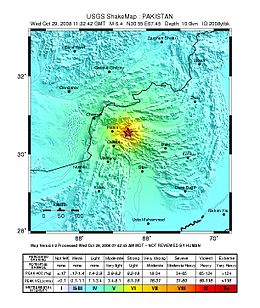2008 Ziarat earthquake
 |
|
| Date | October 29, 2008 (October 28 UTC) |
|---|---|
| Magnitude | 6.4 Mw |
| Depth | 10 km (6.2 mi) |
| Epicenter | 30°34′08″N 67°29′02″E / 30.569°N 67.484°ECoordinates: 30°34′08″N 67°29′02″E / 30.569°N 67.484°E |
| Areas affected | Pakistan |
| Casualties | 215 Dead 200 Injured |
The 2008 Ziarat earthquake hit the Pakistani province of Balochistan on October 29 with a moment magnitude of 6.4. The US Geological Survey reported that the quake occurred 60 km (37 mi) north of Quetta and 185 km (115 mi) southeast of the Afghanistan city of Kandahar at 04:09 local time (28 October, 23:09 UTC) at a depth of 15 km (9.3 mi), at 30.653°N, 67.323°E. It was followed by another shallower magnitude 6.4 earthquake at a depth of 10 km (6.2 mi) approximately 12 hours after the initial shock, at 30.546°N, 67.447°E. 215 people were confirmed dead. More than 200 were injured (according to Mohammed Zaman, assistant to the Balochistan chief secretary, Nasir Khosa), and 120,000 were homeless (according to Dilawar Khan Kakar, Ziarat, Balochistan mayor and chief administrator).The New York Times reported that Qamar Zaman Chaudhry, director general of Pakistan Meteorological Department, stated the quake epicenter was 70 miles (110 km) north of Quetta, and about 600 km (370 mi) southwest of Islamabad. Quetta, Baluchistan's capital, was levelled in 1935 by a magnitude Mw 7.6 earthquake which left 30,000 people dead, according to the US Geological Survey.
Earthquakes and active faults in western and northern Pakistan and adjacent parts of Afghanistan are the result of the Indian plate moving northward at a rate of about 40 mm/yr (1.6 inches/yr) and colliding with the Eurasian plate. Along the northern edge of the Indian subcontinent, the Indian plate is subducting beneath the Eurasian plate, causing uplift that produces the highest mountain peaks in the world, including the Himalayan, the Karakoram, the Pamir and the Hindu Kush ranges. West and south of the Himalayan front, the relative motion between the two plates is oblique, which results in strike-slip, reverse-slip, and oblique-slip earthquakes. The pattern of elastic waves that were radiated by the October 28 and 29, 2008, earthquakes implies that each earthquake was the result of predominantly strike-slip faulting. Seismographically recorded waveforms imply that the shocks were caused by either left-lateral slip on a northeast-striking fault or right-lateral slip on a northwest-striking fault. The tectonic setting favours left-lateral slip on a northeast-trending fault as the likely fault plane.
...
Wikipedia
